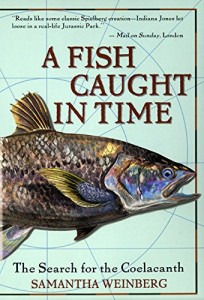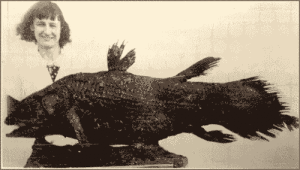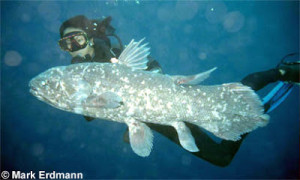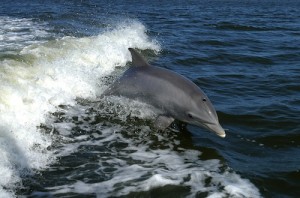by Naomi L. | March 9, 2016 | Blog, Creative Writing, Off The Bookshelf |
How about a new book recommendation for this year’s reading list? This one’s a little different from my other Off The Bookshelf entries as it’s actually a nonfiction tale, and a marine biology-themed one at that! I read this book last year for school, and I was so enraptured by this incredible true “scientific epic” that I had to share it on my blog.
So if you’ve never heard of the coelacanth, or you have but want to learn the details of its history, you’re in for a treat! I hope you’ll enjoy my review of this must-read book: A Fish Caught in Time: The Search for the Coelacanth by Samantha Weinberg.

A Fish Caught in Time: The Search for the Coelacanth, by Samantha Weinberg
Summary
A Fish Caught in Time tells the true story of the coelacanth (SEE-luh-kanth), one of the most mysterious and fascinating fishes (yes, “fishes“) in scientific history, as written by English journalist Samantha Weinberg. Originally published in 1999 by HarperCollins, the book recounts the events surrounding this prehistoric fish, from the shocking discovery of a living specimen (Latimeria chalumnae) in 1938 to the discovery and study of a second species (Latimeria menadoensis) 60 years later. The narrative relates these events from the perspective of the researchers who dedicated much of their time and resources to studying this fish, all of whom played an important role in the amazing story of the elusive “King of the Sea”.
Review
I read this book last year in preparation for a Vertebrate Zoology class I had to help teach as part of my Master’s program. My lesson was about the Sarcopterygii class of fishes, so my professor lent me his copy of A Fish Caught in Time as supplementary material for telling the story of the coelacanth. By the time I was done, I was ready to teach an entire semester on this one fish. I never thought I would feel so strongly about any one fish, but then again, the coelacanth is no ordinary fish.

Marjorie Courtenay-Latimer with the modern coelacanth (Latimeria chalumnae) she discovered in 1938
To summarize, the coelacanth was long thought lost to history by the Cretaceous-Paleogene extinction event that wiped out three quarters of the plant and animal species living on Earth (most famously the dinosaurs). It was known only by its fossil record for (almost exactly) 100 years, until, to the world’s surprise and excitement, a living specimen was fished off the South African coast in 1938. Over the next six decades, the coelacanth would be the focus of global headlines, political plays, and scientific rivalries, all the while remaining an enigma to the world that it continues to captivate to this day.
A rare example of a nonfiction story told in a highly narrative form, A Fish Caught in Time does an excellent job of capturing the majesty and mystery of the coelacanth while staying true to the history of its discovery and study. Ms. Weinberg paints such a vivid picture of this 60-year-long story that I couldn’t help but be completely drawn in, as if I were living the story along with the real-life characters: the excitement of discovering the coelacanth wasn’t extinct after all, the rush to find out where it had been hiding for the past 65 million years, the desperation to not only capture a living specimen but keep it alive at the surface, the awe that only a lucky few in history have ever known of watching this deep-sea fish swim in its natural habitat. I’d even go as far as to say that it’s impossible to read this book and not fall in love with the coelacanth!

Arnaz Erdmann swimming with the Indonesian coelacanth (Latimeria menadoensis)
A fair note of warning: oftentimes the story focuses more on the researchers who dedicated their lives to studying the coelacanth than on the coelacanth itself. Readers who hope to gain an insight exclusively into the life of the fish may find this a bit off-putting, but then again, it hardly makes sense to attempt to recount the history around the animal without offering even a glimpse into the lives of the people who shaped that history. It’s much more than a story about a fish; it’s a lesson about what it means to be a researcher. It takes intelligence, curiosity, patience, an unquenchable thirst for knowledge, and an unrelenting passion for science, all of which shine through the pages of this brilliant narration of scientific truth.
Overall, A Fish Caught in Time is a captivating read that any science enthusiast will enjoy. I owe much of my appreciation for the coelacanth to this book, and I recommend it to anyone who wants to immerse themselves in a world of marine biology without being overwhelmed by the technicalities of it all. As quickly becomes evident from the first chapter, science doesn’t have to be fictional to blend well with creative writing!
Inspiration
I love science and I love a good story, but it’s rare that I get to enjoy both at the same time, or at least in the same book. A Fish Caught in Time offers an opportunity to glimpse the joy and passion that goes into conducting good science by presenting it in an enjoyable narrative format. Though much research has gone into understanding the coelacanth, A Fish Caught in Time never conveys that research in a manner too difficult for the layman to comprehend or appreciate, making it an unusual kind of literary gem: a scientific subject made accessible to the general public, that is, a community of non-scientific readers.
So if you appreciate science and a good story based on true events, A Fish Caught in Time may be just the inspiration you need for your creative writing! It certainly has been for me; in my opinion, there’s never too much writing inspiration to be found in science!
by Naomi L. | March 4, 2016 | J.C. Wolfe's Writing, Short Stories |
I really thought amplifying DNA would be easy. Molecular biology seemed simple enough in theory: extract, amplify, sequence, analyze. But I had no idea how difficult it would be to work with so many variables.
After my third failed polymerase chain reaction attempt, I started to wonder what I could be doing wrong.
Was I using the right concentrations of each reagent? Buffer at 1X, MgCl2 at 1.5mM, dNTPs at 200µM each?
Were the primers optimized for my DNA template? Had they been designed for the correct gene? Did they have the right length, melting temperatures, GC content?
Were the PCR cycles optimized? Was I using an annealing temperature within a few degrees of the primers’ melting temperatures? Were the denaturation and extension times long enough to assure proper replication of the DNA fragments?
Was the electrophoresis gel being prepared and run correctly? 1% agarose gel with GelRed in TAE buffer, run for about 10V per centimeter between the electrodes?
Or what if – shudder – the problem was in the DNA itself? What if the extraction had failed, and I’d have to start the entire project over from Square One?
No, no, calm down, I told myself. One step at a time. First, eliminate the variables you know aren’t the problem. There’s no reason the extraction should have failed; the quantification returned optimal concentrations of DNA. These are the same universal primers used in countless other studies, specifically designed for the cytochrome-b gene. The thermocycler and the electrophoresis apparatus have already worked before. There’s nothing wrong with the gel because the ladder and primers appear in the UV photos. That’s already five ticks off the checklist.
Now start with a positive control, a sample you know has worked with these primers before. PCR #4: did it fail to amplify along with the others? Yes. Good, then the problem isn’t the DNA.
Next step: new aliquots. Replace the water, the buffer, the MgCl2, the dNTPs, even the primers. Everything must be fresh to minimize contamination. Double-check the concentrations before preparing the mix. PCR #5: still no bands in the gel. No problem; just move on to the next step.
Try altering the reagent concentrations. Use more DNA template, double the primers, increase the amount of MgCl2. PCRs #6-8: nothing. Don’t panic, it’s all part of the process. You’re zeroing in on the problem now.
Adjust the PCR procedure. Increase the number of cycles, raise the annealing temperature in increments of 2ºC, lengthen the initial denaturation and final elongation steps. PCRs #9-12: still nothing. It’s okay, every failure is just another step closer to success. These tears are totally normal; nothing to be ashamed of.
For weeks, I tried everything I could think of. I replaced the reagent aliquots three times. I used half a dozen standard PCR procedures from various troubleshooting references. I ran gradient tests and touchdown tests and hot-start tests. Zero, nothing, zip.
Finally, after over a month of PCR attempts and no results to show for it, I was at my wit’s end. One morning, when I was alone in the lab, I broke down into a sobbing mess. I couldn’t look at the thermocycler anymore, that beast of a machine that I had to work with every day. I felt like a knight facing off against the same dragon over and over, knowing that hours of battling would only get me burnt every single time.
So I resolved to take a break from it all. No more PCRs for a while, not until I could work up the energy to start trying again. Today, I would just sit at the desk and read papers while indulging in a bag of cookies. Stale cookies. Really stale cookies. Seriously, how old were these?
I turned the bag over to check the date on the back…and that was when it hit me. Could it be? Immediately I dropped the bag and ran to the freezer. The stock solutions were stored in the back of the bottom shelf; I searched through them one by one until at last I found what I was looking for, printed clear as day inside the lid of the Taq DNA polymerase box. “Expiration date: Oct 2010.” Of course! No wonder none of my reactions were working: the enzyme was over five years old!
My first grin in weeks spread across my face, and I was suddenly overcome with an urge to shout “Eureka!” I hurried to my professor’s office and told him about the expired reagent. He quickly ordered a new stock and it arrived within two weeks. Sure enough, the next PCR I ran yielded the most beautiful set of bright DNA bands I had ever seen in a gel. I wanted to kiss that UV photo. My very first successful DNA amplification! And it only took two months longer than expected.
Never again will I underestimate the work of a scientist. Molecular biology may seem simple in theory, but having learned my lesson the hard way, next time I’ll be prepared for the challenge of working with too many variables.
by Naomi L. | September 4, 2015 | J.C. Wolfe's Writing, Poetry |
Beautiful Earth full of life,
I love to study your ecosystems, from your
Oceans teeming with fascinating creatures to your
Landscapes rich with lush vegetation.
Only your beautiful nature, rich with
Greens and blues, can pique such curiosity in me.
Your living world is my science, my knowledge, my life!
by Naomi L. | September 11, 2013 | Blog, Creative Writing |
Hello, and welcome to another Writers Reveal (formerly Secret Subject Swap) post, brought to you by Emily Morgan of Emily Morgan Writes. This month’s topic was sent to me by Melissa, who suggested the prompt “When I grow up… Water”. Based on that idea, I decided to write about my thoughts as a child on what else besides a writer I wanted to be when I grew up. Thanks for the topic, Melissa!
The Dreams of Children
Elementary school is an important time in every person’s development. It’s that time when we learn the basic knowledge that will get us through the rest of our lives, when our minds are always buzzing with hundreds of questions about the world around us (or at least, mine was). It’s also a time when many of us start to think about what career paths we’d like to follow in the future.
When we were still children, grown-ups started asking us what we wanted to be when we were older, and those of us who took the question seriously began to ponder the possibilities. Some of us chose to become doctors. Some of us chose to become lawyers. Some of us chose to become scientists, or journalists, or politicians. Some of us chose to become athletes. And some of us chose to become artists.
But how many of us stuck to the first plan that came to mind? How many of us had only one plan to begin with?
I didn’t.
My Other Dream
Writing about what I wanted to be when I grew up is easy, but I still had to think about the last part of Melissa’s prompt: “water”. What could I say about “water”? I could write a fictional story about a young girl with a dream to study the ocean, but it would still be based heavily on real facts, because the truth is… that’s my story.
The first time I knew I wanted to be a writer was in the fourth grade. Creative writing was my greatest passion at the time, and I knew in my heart it was a decision that I was going to stick to for the rest of my life. But writing wasn’t the only career I wanted to pursue when I was a kid, because I had another passion: science.
 Ever since I was about six years old, my favorite animal has been the bottlenose dolphin, mostly for its incredible intelligence and playful nature. Having spent a large part of my childhood living in southern Florida, my parents used to take us to Orlando all the time, where we’d visit all the big theme parks, including Sea World. It was there that I really developed a major interest in marine mammals, and I loved the attractions with dolphins so much that I eventually decided I wanted to be a dolphin trainer.
Ever since I was about six years old, my favorite animal has been the bottlenose dolphin, mostly for its incredible intelligence and playful nature. Having spent a large part of my childhood living in southern Florida, my parents used to take us to Orlando all the time, where we’d visit all the big theme parks, including Sea World. It was there that I really developed a major interest in marine mammals, and I loved the attractions with dolphins so much that I eventually decided I wanted to be a dolphin trainer.
Over time, my passion for dolphins grew into a passion for ocean life in general, so that by the time I was in high school, my original plan had evolved from pursuing dolphin training to studying marine science. Years later, I graduated from university, and I now have a Bachelor’s degree in Biology.
From Dreams to Reality
So now what? Now I’m pursuing both my chosen career paths: creative writing and marine biology. I’m still doing research at my university while I prepare to start working toward a Master’s degree in Ecology, specializing in marine environments. In the meantime, I’m working on this blog to develop my skills and my identity as a writer, and I’m writing stories to release the creative energy inside me.
But these two paths are certainly not mutually exclusive. As a writer, I plan to draw from my experiences in science to write sci-fi stories with as much accurate detail as possible. As a biologist, I need to be skillful at writing to turn out high-quality papers for scientific journals, not to mention I need to be a creative thinker. In short, being able to follow both these paths is a wonderful experience, a real dream come true. I’m a scientist by day, an artist by night, and a dreamer by always.
What about you? What else did you want to do in life besides writing?
This has been a special topic post in Emily Morgan’s Writers Reveal. To learn more, just follow the button below to her site, and be sure to check out the other blogs participating in the event. Thanks for reading!

Other bloggers in the Writers Reveal
Melissa Khalinsky: Melissa Writes
Jodi Gibson: JFGibson
Becky Fyfe: Imagine! Create! Write!
Josefa: Always Josefa
Rhianna: A Parenting Life
Ashley Howland: Ghostnapped
Zanni: My Little Sunshine House
by Naomi L. | August 2, 2013 | Flash Fiction, J.C. Wolfe's Writing |
Light. Move. Light grows. Crawl out. Buzz. Bright light. Crawl from egg. Free.
Wings. Grow. Flap. Buzz. Flap, flap. Whir. Fly.
Light is bright. Fly around, see many others. Buzz around. Food is close. Smell the food, land. Feed. Flap again, buzz again. Fly away.
Light is bright. Fly around, see many others. Buzz around. Food is close. Smell the food, land. Feed. Flap again, buzz again. Fly away.
Female…
Light is bright. Fly around, see many others. Buzz around. Food is close. Smell the food, land. Feed. Flap again, buzz again. Fly away.
Movement. Ground shifts. What? What is that? Large eyes. Something sees us.
New food. Ground moves. Smell other food. Dark, then light. Fly, find the food. Feed. Flap, buzz. Fly away.
Brighter light now. What is this? Ground moves again. Ground is… in the air?
New ground moves away. Change in the air…
Aaahhh!!! It burns!
Fall…
Cold ground. Bright light. Twitch. Darkness closes in… In the air, hear a sound…
“Drosophila.”
The idea for this piece came to me some years ago, when I was taking a Classic Genetics class for my Biology course. The story depicts the course of a genetic drift experiment as told from the perspective of one of the test subjects: a fruit fly of the genus Drosophila. Fruit flies are very commonly used in simple genetics experiments, and for some reason I thought it might be interesting to try writing a story about their life course during an experiment: over two weeks, the flies are hatched in a jar with a floor covered in a special nutrient mix, left to grow and reproduce, moved to another jar so as not to crossbreed with the new generation of flies, and eventually knocked out with alcohol fumes and placed under a magnifying glass for observation. The simplicity of the writing is meant to mirror the simplicity of the fly and its life, and the repeated paragraphs reflect what I assume would be the fly’s extremely short memory span and limited activity inside the jar.
Hope you’ve enjoyed the piece! Thanks for reading!




 Ever since I was about six years old, my favorite animal has been the bottlenose dolphin, mostly for its incredible intelligence and playful nature. Having spent a large part of my childhood living in southern Florida, my parents used to take us to Orlando all the time, where we’d visit all the big theme parks, including Sea World. It was there that I really developed a major interest in marine mammals, and I loved the attractions with dolphins so much that I eventually decided I wanted to be a dolphin trainer.
Ever since I was about six years old, my favorite animal has been the bottlenose dolphin, mostly for its incredible intelligence and playful nature. Having spent a large part of my childhood living in southern Florida, my parents used to take us to Orlando all the time, where we’d visit all the big theme parks, including Sea World. It was there that I really developed a major interest in marine mammals, and I loved the attractions with dolphins so much that I eventually decided I wanted to be a dolphin trainer.

Recent Comments